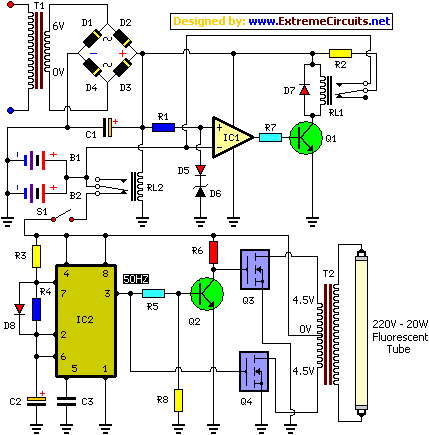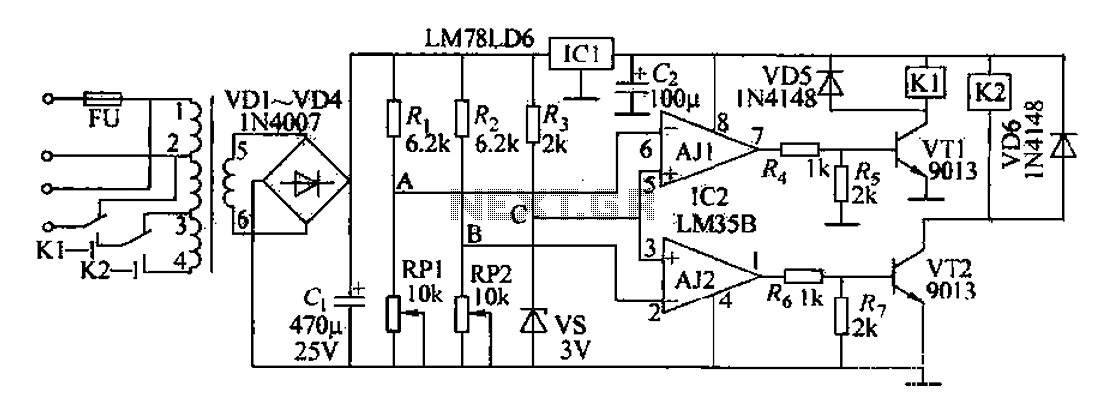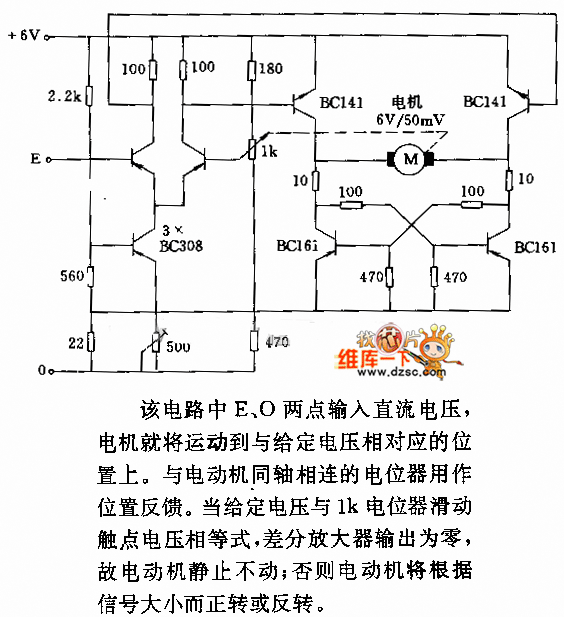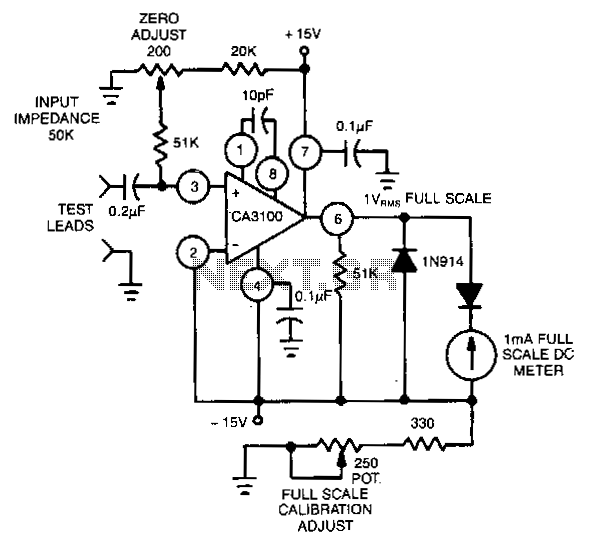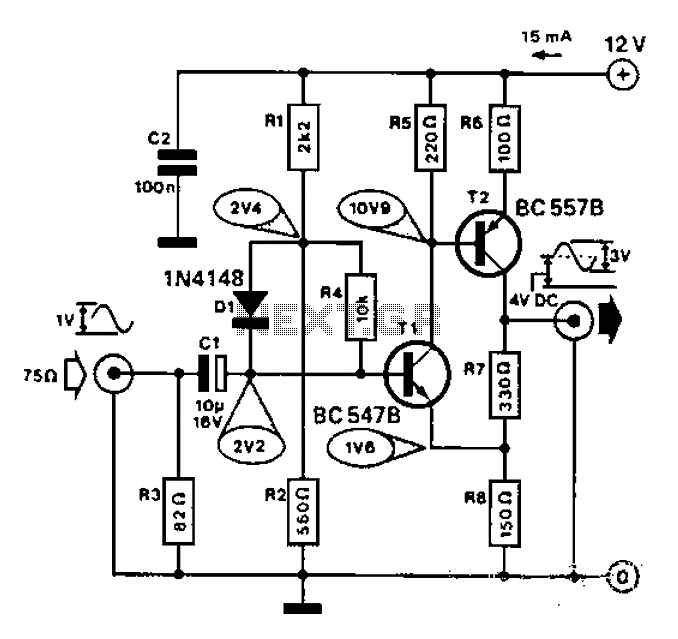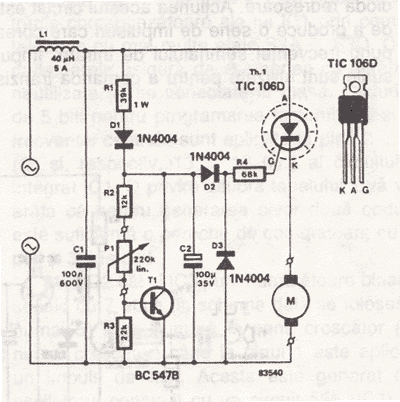
Audio-Frequency Meter Circuit
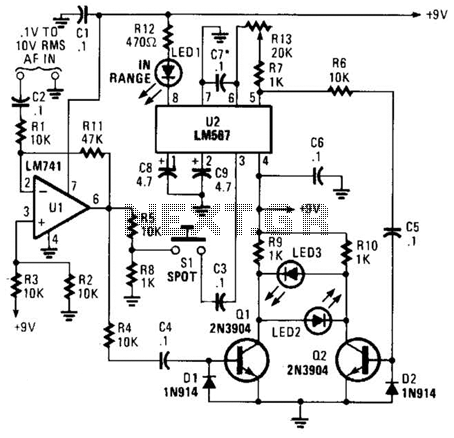
This meter is unique as it does not utilize a D'Arsonval movement or digital display for frequency readings. Instead, the measured frequency is indicated on a hand-calibrated dial. Any audio signal applied to the circuit is amplified by U1, and the resulting output is divided into two paths. One path directs the output signal to the mixer, while the other path routes the signal to the input of U2 via S1, a normally open pushbutton switch. The portion of the amplifier signal sent to the mixer is applied to the base of Q1, causing it to toggle on and off at the signal frequency. In the alternate path, when S1 is pressed, a portion of the op-amp's output is directed to U2. If the signal falls within the operating frequency range of U2's internal oscillator, LED1 illuminates, and a signal is sent to the base of Q2. If the signals arriving at the mixer do not match precisely, LED2 and LED3 light up, indicating that the circuit requires fine-tuning. This is achieved by releasing S1 and adjusting R13 until LED2 and LED3 turn off. The dial setting at this point indicates the frequency of the input signal to within 1 Hz (or as accurately as the calibrated dial permits).
This unique frequency meter employs a combination of analog and digital techniques to achieve accurate frequency measurement without relying on conventional display methods. The circuit begins with an audio signal input, which is amplified by operational amplifier U1. The output from U1 is split into two distinct paths. The first path directs the signal to a mixer circuit, which is responsible for combining the input frequency with a reference frequency. The second path involves a pushbutton switch S1, which, when pressed, allows a portion of the output from U1 to be routed to the input of U2, another operational amplifier configured as an oscillator.
The toggling action of transistor Q1, driven by the signal fed from the mixer, allows for the detection of frequency variations. When the signal is within the operational range of U2's internal oscillator, it triggers LED1, indicating a successful frequency match. The system utilizes feedback from the mixer to ensure that both signals are synchronized. If they are not, LED2 and LED3 illuminate, signaling the need for adjustment.
The fine-tuning process is critical for achieving high accuracy. By releasing S1 and adjusting the variable resistor R13, the user can calibrate the circuit until the indicators (LED2 and LED3) turn off, signifying that the input signal frequency has been accurately matched to the reference frequency. The final reading is displayed on the hand-calibrated dial, providing a precise frequency measurement within a tolerance of 1 Hz. This design emphasizes user engagement through manual calibration while maintaining high accuracy and functionality in frequency measurement applications. This meter differs from the norm in that it does not use a D`Arsonval movement or digital display to give a reading of the input frequency. Instead, the measured frequency is read from a hand-cali-brated dial. Any audio signal applied to the circuit is amplified by Ul and the resulting output is divided along two paths.
In one path, the output signal is applied to the mixer; in the other path, the signal is applied to the input of U2 through SI (a normally open pushbutton switch). The portion of the amplifier signal that is fed to the mixer is applied to the base of Ql, causing it to toggle on and off at the signal frequency.
In the other path, when SI is pressed, a portion of the op amp`s output is applied to U2. If the signal is within the range of U2`s internal oscillator`s operating frequency, LED1 lights, and a signal is fed to the base of Q2. If the two signals arriving at the mixer do not match exactly, LED2 and LEDS light. That means that the circuit must be fine tuned, which is accomplished by releasing SI and fine tuning R13 until LED2 and LED3 go out.
The dial setting at that point gives the frequency of the input signal to within 1 Hz (or as close as the calibrated dial will allow). 🔗 External reference
This unique frequency meter employs a combination of analog and digital techniques to achieve accurate frequency measurement without relying on conventional display methods. The circuit begins with an audio signal input, which is amplified by operational amplifier U1. The output from U1 is split into two distinct paths. The first path directs the signal to a mixer circuit, which is responsible for combining the input frequency with a reference frequency. The second path involves a pushbutton switch S1, which, when pressed, allows a portion of the output from U1 to be routed to the input of U2, another operational amplifier configured as an oscillator.
The toggling action of transistor Q1, driven by the signal fed from the mixer, allows for the detection of frequency variations. When the signal is within the operational range of U2's internal oscillator, it triggers LED1, indicating a successful frequency match. The system utilizes feedback from the mixer to ensure that both signals are synchronized. If they are not, LED2 and LED3 illuminate, signaling the need for adjustment.
The fine-tuning process is critical for achieving high accuracy. By releasing S1 and adjusting the variable resistor R13, the user can calibrate the circuit until the indicators (LED2 and LED3) turn off, signifying that the input signal frequency has been accurately matched to the reference frequency. The final reading is displayed on the hand-calibrated dial, providing a precise frequency measurement within a tolerance of 1 Hz. This design emphasizes user engagement through manual calibration while maintaining high accuracy and functionality in frequency measurement applications. This meter differs from the norm in that it does not use a D`Arsonval movement or digital display to give a reading of the input frequency. Instead, the measured frequency is read from a hand-cali-brated dial. Any audio signal applied to the circuit is amplified by Ul and the resulting output is divided along two paths.
In one path, the output signal is applied to the mixer; in the other path, the signal is applied to the input of U2 through SI (a normally open pushbutton switch). The portion of the amplifier signal that is fed to the mixer is applied to the base of Ql, causing it to toggle on and off at the signal frequency.
In the other path, when SI is pressed, a portion of the op amp`s output is applied to U2. If the signal is within the range of U2`s internal oscillator`s operating frequency, LED1 lights, and a signal is fed to the base of Q2. If the two signals arriving at the mixer do not match exactly, LED2 and LEDS light. That means that the circuit must be fine tuned, which is accomplished by releasing SI and fine tuning R13 until LED2 and LED3 go out.
The dial setting at that point gives the frequency of the input signal to within 1 Hz (or as close as the calibrated dial will allow). 🔗 External reference
Warning: include(partials/cookie-banner.php): Failed to open stream: Permission denied in /var/www/html/nextgr/view-circuit.php on line 713
Warning: include(): Failed opening 'partials/cookie-banner.php' for inclusion (include_path='.:/usr/share/php') in /var/www/html/nextgr/view-circuit.php on line 713
